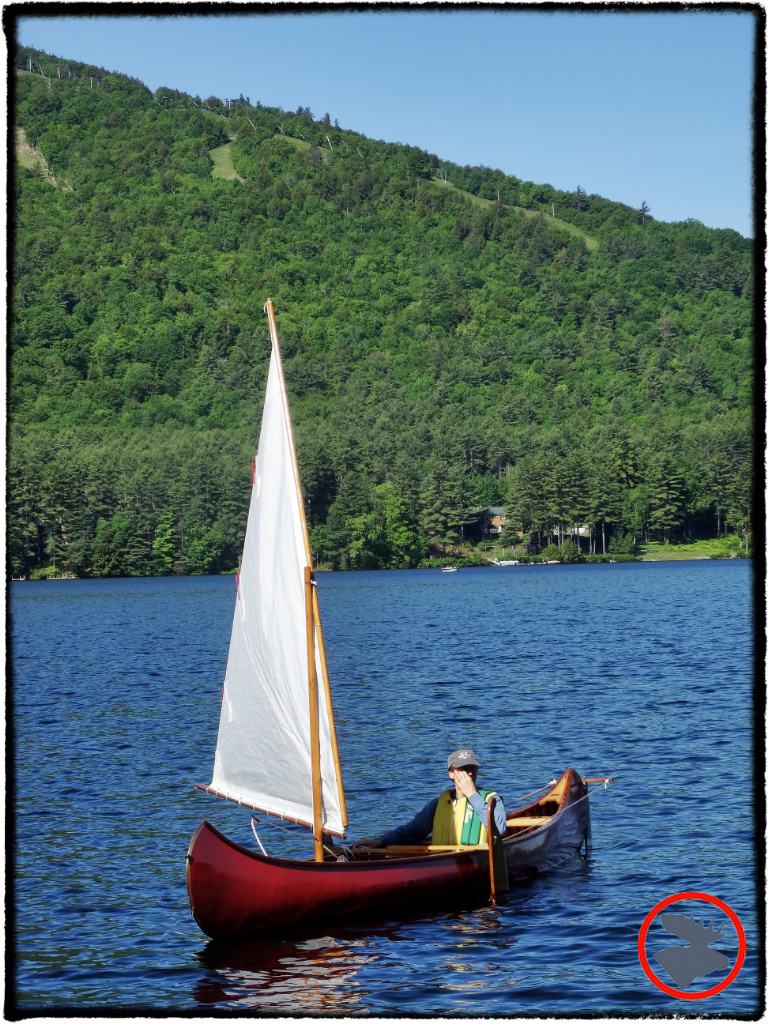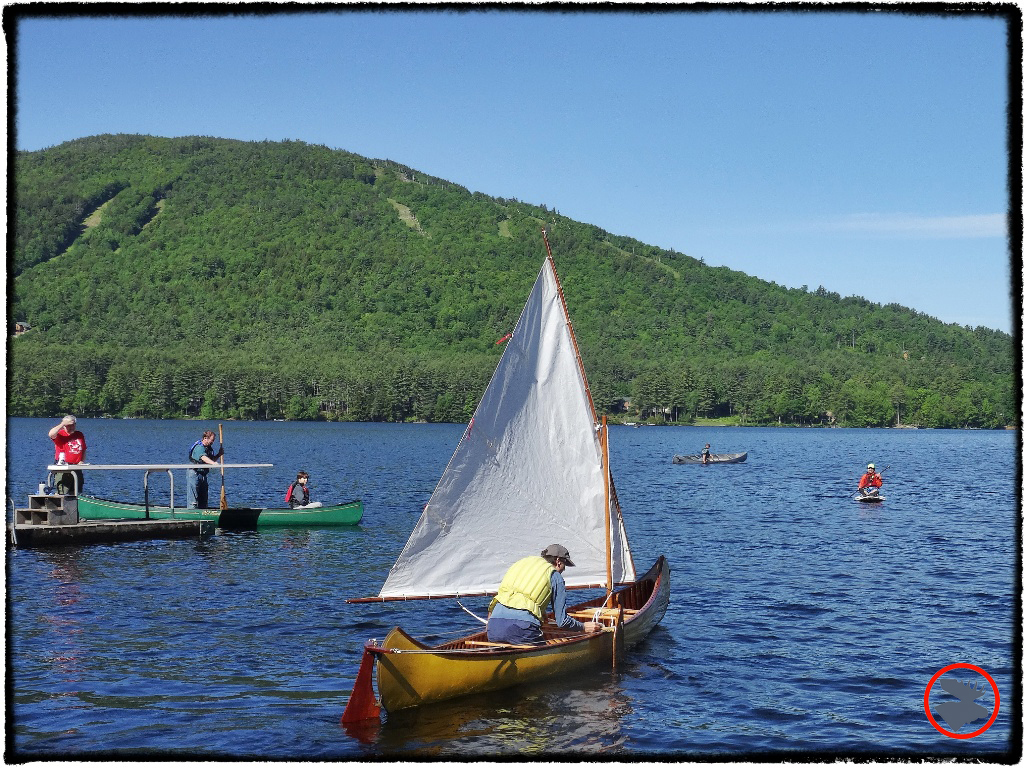Maine Canoe Symposium is held annually in April.
Huzzah! Huzzah! Huzzah!
It was opening night at the Maine Canoe Symposium (“MCS”) and Harry Rock, legendary canoe poler, was at the podium working the crowd into a frenzy with his “poler’s war cry.” This fierce gesture involved thrusting a pointed finger (or pole!) toward the heavens and roaring out a "Huzzah" like a lancer charging along with the Light Brigade at the Crimea. “Why would you want to sit and pull your canoe along, when you can stand tall and carry a big stick? Huzzah! Polers do it standing up!" I couldn’t resist getting caught up in the frenzy.
I’d wanted to attend the Maine Canoe Symposium for years, and finally made it back in April of this year when I was in Maine for an incredible five-day canoe trip down the Machias River and day trips on the Ossippee River and Kendsukeg Stream.
Learning at MCS
The MCS had two major elements that got my attention:
1. Canoe poling! This incredibly fun and useful skill is all but lost in most areas. In Maine and the Northeast, however, there are a few skilled practitioners of this ancient technique remaining. Harry Rock, the opening night speaker who was riling the crowd into frenzy, has written books and produced DVDs on the subject, and he is one of the best canoe polers alive. He was undefeated for 10 years, and holds 11 world championships in the competitive sport version of poling. In addition to Harry, there were many other master polers at the symposium.
2. Hands-on learning. It’s a three-day event held at a beautiful summer camp in the Maine woods where attendees stay on site and attend both land-based and on-the-water classes with a strong focus on developing their camping/wilderness and canoeing skills. These classes give attendees hands-on instruction from experts in a range of canoeing techniques. It’s an invaluable opportunity to spend time on the water with expert instructors.
Peaceful waters at Maine Canoe Symposium 2014.
MCS Keynote Speakers
After Harry Rock got everyone stoked up about the next few days of MCS, Dan Pelletier gave Friday night’s keynote presentation. Dan talked about his experience paddling the Yukon River in his younger days when he jumped in an old pickup truck with his dog and a 20’ Old Town Tripper XL canoe, and no particular timetable. Dan is an experienced guide with a laidback, friendly, unassuming manner. His excellent Yukon River trip report had us dreaming about heading north and living in the wilderness for the rest of the summer. Dan also offered good advice in later breakout sessions about campfire cooking for a group and shared how he packs to guide canoe trips. After MCS finished, I was able to spend a day on Kenduskeg Stream—a fast, boulder-filled river in central Maine—with Dan to specifically work on poling skills. Dan was a patient and effective teacher, and I was really happy with my progress. If you’re interested in experiencing a trip on one of the many great rivers in Maine, I’d certainly check out Dan’s guiding services.
On Saturday night, the theme of youthful adventure continued with Amy Lukas and Mary Catterlin, two young women from Indiana, who by paddle and sail, took their handmade dugout canoe around the entire perimeter of Lake Michigan. The attendees clearly loved Amy and Mary’s spirit of adventure, as well as admired the effort and perseverance needed to prepare for and complete their voyage.
MCS Classes
I attended many great classes at MCS, both on land and water, but one of my favorite parts of the weekend was the Saturday morning waterfront demonstration of different paddling styles. Presenters running the workshops paraded through the waterfront area on their canoes, showing off their paddle styles and techniques:
Harry Rock riling up the crowd once again with his canoe poling skills.
Freestyle Paddling
Kim Gass is a well-known freestyle canoe enthusiast and instructor. Most people have probably never seen or heard of freestyle canoeing. It’s a very artful style of mastering canoe control with a minimal movements that she clearly has a handle on.
Traditional Flatwater Paddling
Caleb Davis makes beautiful handcrafted paddles and is a teacher of traditional flatwater, or “Canadian style,” paddling. Traditional flat water paddling is similar to freestyle paddling with a few key differences. Freestyle is often performed in a scaled-down solo canoe using strokes on both sides of the canoe. Canadian style paddling, on the other hand, is done on one side in a regular full-sized canoe. With both variations, the paddler will often heel the canoe over until one gunnel is near the water in order to lift the stems out of the water and allow the canoe to pivot directly under the paddler. Caleb had one of the best entrances in the waterfront exhibition of paddling styles as he smoothly cruised in and demonstrated a series of masterful spins and maneuvers in a typical dented up old aluminum canoe—showing triumph of technique over gear! I think Caleb’s exhibition could breathe life into the waterfronts of summer camps everywhere. Attempting to master that kind of boat control seems like it could appeal to the skate and snowboard gang.
Sport/Modern Poling
Harry Rock once again got the crowd fired up with his flashy entrance, powering into the waterfront area with his pole, neatly rocketing the canoe through a square pattern, stopping, and poling backward to reverse his pattern. Modern polers typically use a squared-off “power stance,” frequently use both ends of the pole (which is often aluminum), and favor canoes in the 16’ range.
Traditional Poling
Lisa DeHart and Kevin Silliker offered classes on traditional poling. Lumberman and guides have long used this style of propulsion to move supplies and people up and down river. It differs from sport/modern poling because it is typically performed at an angled stance with primarily only one end of the pole getting wet. Wooden poles and long canoes are favored. Generally, the objective with traditional style poling is to safely move people and gear along the waterways, whereas sport polers are competing for time through designated obstacles; however, there can be plenty of crossover.
Canoe Sailing
Benson Gray sailed in with an incredible vintage wooden canoe. One side painted yellow, the other side painted red. He explained that it was a photographer’s canoe, painted two colors so a photographer could choose which color he wanted for his shots.
Double-Bladed Paddling
Geoff Burke, a well-known wooden boat builder, talked about the history of using double-bladed paddles with canoes. Geoff also gave a must-attend talk for axe nuts.
Stand-up Paddling
Stand up paddling (“SUP”) is all the rage these days, and Paul Faria introduced this crowd—made up largely of traditionalists—to the sport. He, in part, answered some of my questions as to why SUP has gotten so popular with one quick line, “It has a very short learning curve.”
John Meader showcasing his stand-up paddling skills at Maine Canoe Symposium. "Why? Well, in part because I'm too cheap to buy a SUP board!"
Stand-up Canoeing
Do you need a special paddle board to stand up on the water? Do you even need a pole? No. Rebelling against everything anyone’s mother has told them, John Meader says standing up while paddling a canoe is just fine. He demonstrated how to maneuver a canoe while standing using the traditional Maine-style long paddle, and he did it effortlessly. I know the guides of yore favored standing when looking for fish and game, and it seems the tradition lives on in Maine because many of the Mainers I've paddled with are always looking for a reason to stand up in their canoes. It is a fun change of scenery, requires the use of different muscles, and can really help in plotting your course, but I still hear my mom’s dire warnings nagging at me in the back of my head every time I do it.
Advanced Whitewater Skills
Rory Matchett and Kevin Silliker from New Brunswick were on hand offering advanced paddling classes on perfecting eddy turns, pivoting a canoe, and poling. These guys were great instructors, and a ton of fun! They kept it light and fully engaging, while providing plenty of feedback and advice. In confidence, they even told me it was the other guy's fault when that guy and I took a cold bath while trying to execute an aggressive eddy turn! They wouldn't have told him the same thing, would they have? I really enjoyed chewing the fat with these guys in the evenings.
Woman in back. The key to a happy paddling marriage?
North American Touring Technique
Jim and Lisa Lisius paddled across the country—the first time anyone had done so. The truly amazing thing is that they are still married! I only caught their intro on the waterfront, but it was impressive watching their fast, efficient, racing-style cruising. My only complaint was that they kept referring to their style as “North American Touring Technique” or “Sit and Switch,” instead of the “Minnesota Switch” as all of us here at home know it should properly be attributed!
Northwoods Stroke
Jane Barron and Lynne Lewis demonstrated the Northwoods Stroke. It was good to hear Jane’s interpretation of this traditional touring stroke and great fun cruising Moose Pond in the wood-canvas Atkinson Travel she made. I was excited to meet Jane, the owner and craftsperson behind Alder Stream Canvas, because I’ve bought a few of her items (e.g., a utensil roll and a pack basket liner) which have proven to be great pieces of gear.
Shawn Burke cruising through the Maine Canoe Symposium waterfront.
Marathon Canoe Racing
Shawn Burke is a veteran canoe racer, and came in like a rocket with his sculpted composite racing hull. There were some chuckles all around when Shawn admitted that due to the boat’s long, squared-off ends, he couldn’t actually turn the canoe around in the exhibition space. I later had the chance to have a few casual conversations with Shawn, and it became clear to me that he is passionate about canoes, the fitness benefits he gets from racing canoes, and the MCS.
David Lewis with his Rollin Thurlow canoe and appropriate accouterment.
Land-based Classes
In addition to the on-water classes, there were plenty of great land-based classes. I was on the lake most of the time, but I did manage to catch David Lewis' talk on traditional gear, packing, and travel style. There was more romance and style in his 17'6" wooden Atkinson Traveller, pack basket, and wannigan than in an outfitter's entire lot full of synthetic canoes and blue plastic barrels!
Plan to Attend MCS!
The Maine Canoe Symposium seems to be largely unknown outside of that region, but it’s a fantastic event for anyone wanting to learn more about canoes, wilderness camping, and paddling skills, or for anyone who just wants to hang out with fellow bush nuts. If you live in the northeast, love the woods and water, get yourself to this event. If you're not from the area, consider making a combo trip out of it like I did. Paddle a great river, like the St. John, Machias, or the East Branch of the Penobscot, eat a bunch of lobster, and then come learn and swap stories at the Symposium!
Great Lakes Region Canoe Events
There are some fantastic events in the Great Lakes area designed for people who love traveling wilderness waters to gather and share stories, techniques, and trip reports:
Midwest Mountaineering’s Outdoor Expos
The Minnesota Canoe Association’s Far North and Near North Symposiums
Rutabaga’s Canoecopia (Madison, WI)
Quiet Water Symposium (Lansing, MI)
These shows offer tons of good information, but little to no hands-on training.
Any other great paddling events we should know about? Let us know!









